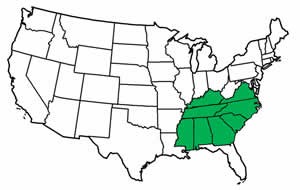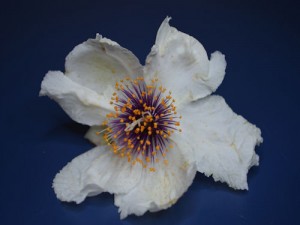Stewartia ovata (Mountain Stewartia)
|
|
|
|
Type: Deciduous tree
Hardiness Zone: 5-9
Sunlight: Full sun to part shade
Soil Moisture: Moderate
Soil pH: Acid (4.5-6.5)
Flowering: July – August
Flowers: White
Leaves: Orange to red fall color
Height:10 to 15 feet
Shrubs or small trees to 6 m., usually with several limbs from the base; periderm on young shoots silvery gray-brown, with long, longitudinal fissures, the bark non-exfoliating, grayish-brown, tight, with close, shallow fissures; winter buds small, 2-5 mm. long, with one pubescent scale enclosing the silvery-pubescent embryonic leaves. Leaf petiole 4-14 mm. long with winged margins, the margins enclosing and concealing the axillary and terminal buds; leaf blades ovate to ovate-lanceolate, (3-) 7-15 cm. long, (2-) 4.5-7 (8.5) cm. wide, with acute to shortly acuminate apices, rounded bases, and ciliate, obscurely serrulate margins with apiculate teeth; upper surface glabrous, lower surfaces finely pubescent, particularly along the veins. Flowers axillary, pedicels short and stout, 3-4 mm. long; one bract subtending the calyx, foliaceous, 11-14 mm. long, 3.5-4.5 mm. wide, oblong with an acute apex, persistent. Sepals 5 (or occasionally 4), connate at base, 14-17 mm. long, 6-9 mm. wide, the free lobes lanceolate-oblong with acute apices and ciliate margins; sepals erect in bud, persistent, spreading-erect in fruit. Petals 5, free to the base, 2.8-4.2 cm. long, 2.2-3 cm. wide, obovate to suborbicular, margins erose and wavy. Stamens numerous, the filaments united into a short tube at base, 3-4 mm. long, adnate to the corolla, the free portions 10-12 mm long above, white, yellowish, or rose; anthers yellow. Ovary conical, 5-6 mm. long at anthesis, irregularly 5-lobed, densely sericeous, particularly toward the base of the styles; styles 5, distinct, subequal, 12-14 mm. long, each terminating in a small capitate stigma. Capsules reddish brown, finely pubescent, particularly along the margins of the locules, ovoid with truncate apices (the styles persistent at varying lengths) and strongly 4- or 5-angled, 18-22 mm. long, 14-16 mm. broad, apically dehiscent into 4 or 5 locules, the locule walls 6-7 mm. Seeds 2 per locule, reddish brown, 8-10 mm. long, 5-7 mm. wide, plano-convex, obovate to oblong in outline, narrowly winged, the apex rounded or sometimes emarginated, the raised central portion finely rugose. 2n=30. ***Further diagnostics have found that the apices of the capsule are forked.
![]()
 GLOBAL DISTRIBUTION
GLOBAL DISTRIBUTION
Known from the mountainous and adjacent Piedmont of Kentucky, Tennessee, North and South Carolina, Georgia and Alabama; occurring in two disjunct populations on the Coastal Plain of Virginia. Also occurs in Mississippi, according the Flora of North America.
![]() CULTIVARS
CULTIVARS
![]()
Stewartia ovata ‘Red Rose’ – “In 1967 I received seeds collected in the wild at Williamsburg, Virginia, from a stand mentioned in Colonial times. Seventeen years later one plant in bloom was named ‘Red Rose’ for the color of its filaments—the anthers are yellow. The white flowers open in late July.” From the notes of Polly Hill
![]()
Stewartia ovata ‘Royal Purple’ – “As Colonial Williamsburg was at one time the capital of the colony under English rule, the name of this local inhabitant seems justified. The mountain stewartia had a stand in their native woodland still present in 1967 when I requested seeds. The name refers to the stamens which show the rich color of their filaments against the white petals. The anthers are golden yellow. The species ovata is hardy in zone 6 and adapts to our conditions. The flowers bloom in mid- to late July. For the summer visitors this late timing is much appreciated. The fall foliage of Stewartia ovata is rich in bronze and purple tones.” From the notes of Polly Hill
![]()
Stewartia ovata ‘White Satin’ – “A second seedling from the 1967 seed was named ‘White Satin’ as the filaments are white against the silky white petals. The plants are shrubby from six to ten feet tall” From the notes of Polly Hill
![]()
Stewartia ovata ‘Inner Light’ – The plants unique features are the golden boss of stamens, and distal leaves which are a burgundy color and last nearly the entire growing season. The plant was a rescued seedling that PHA Executive Director, Tim Boland found in 2006 while removing invasive plants along the west stone wall of the arboretum. It was transplanted to his garden, and after 7 years flowered and has been spectacular ever since! (The tree is not yet formally registered).
Tree logo indicates introduction by Polly Hill Arboretum
Descriptions from Stephen A. Spongberg, 1974, A Review of Deciduous-Leaved Species of Stewartia (Theaceae), Journal of the Arnold Arboretum 55: 182-214.
